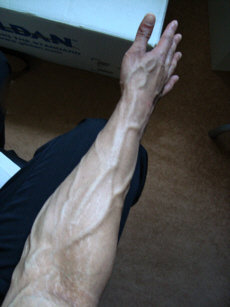Vascularity on:
[Wikipedia]
[Google]
[Amazon]
 Vascularity, in
Vascularity, in
 Vascularity, in
Vascularity, in bodybuilding
Bodybuilding is the practice of Resistance training, progressive resistance exercise to build, control, and develop one's skeletal muscle, muscles via muscle hypertrophy, hypertrophy. An individual who engages in this activity is referred to a ...
, is the condition of having many highly visible, prominent, and often extensively-ramified superficial vein
Superficial veins are veins that are close to the surface of the body, as opposed to deep veins, which are far from the surface.
Superficial veins are not paired with an artery, unlike the deep veins, which are typically associated with an art ...
s. The skin appears "thin"—sometimes virtually transparent—due to an extreme reduction of subcutaneous fat
The subcutaneous tissue (), also called the hypodermis, hypoderm (), subcutis, or superficial fascia, is the lowermost layer of the integumentary system in vertebrates. The types of cells found in the layer are fibroblasts, adipose cells, and ...
, allowing for maximum muscle definition.
Vascularity is enhanced by extremely low body fat
Adipose tissue (also known as body fat or simply fat) is a loose connective tissue composed mostly of adipocytes. It also contains the stromal vascular fraction (SVF) of cells including preadipocytes, fibroblasts, Blood vessel, vascular endothel ...
(usually below 10%) and low retained water, as well as the muscle engorgement ("pump") and venous distension accentuated by the vigorous flexing and potentially hazardous Valsalva effect which characterize competitive posing. Genetics and androgenic hormones will affect vascularity, as will ambient temperature. Additionally, although some bodybuilders develop arterial hypertension
Hypertension, also known as high blood pressure, is a Chronic condition, long-term Disease, medical condition in which the blood pressure in the artery, arteries is persistently elevated. High blood pressure usually does not cause symptoms i ...
from performance-enhancing substances and practices, "high" venous pressure—being an order of magnitude lower than that of arteries— neither causes nor is caused by vascularity. Some bodybuilders use topical
A topical medication is a medication that is applied to a particular place on or in the body. Most often topical medication means application to body surfaces such as the skin or mucous membranes to treat ailments via a large range of classes ...
vasodilator
Vasodilation, also known as vasorelaxation, is the widening of blood vessels. It results from relaxation of smooth muscle cells within the vessel walls, in particular in the large veins, large arteries, and smaller arterioles. Blood vessel wal ...
s to increase blood flow to the skin as well. Although historically controversial, vascularity is a highly-sought-after aesthetic
Aesthetics (also spelled esthetics) is the branch of philosophy concerned with the nature of beauty and taste, which in a broad sense incorporates the philosophy of art.Slater, B. H.Aesthetics ''Internet Encyclopedia of Philosophy,'' , acces ...
for many male bodybuilders, but less so for female bodybuilders, where the target aesthetic is relatively more towards aesthetic symmetry than extreme development.
Bodybuilders or athletes sometimes dehydrate themselves a few days before a competition or show to achieve this so-called "ripped," vascular look. Self-dehydration is not recommended by medical professionals, as the negative and sometimes-fatal effects of the resultant water-electrolyte imbalances are well documented.{{cite news, title=Diuretics in Bodybuilding: The Good, the Bad, the Tragic, last=Marteski, first=Steve, url=http://www.allmaxnutrition.com/post-articles/supplements/diuretics-in-bodybuilding-the-good-the-bad-the-tragic/, access-date=September 21, 2012
References